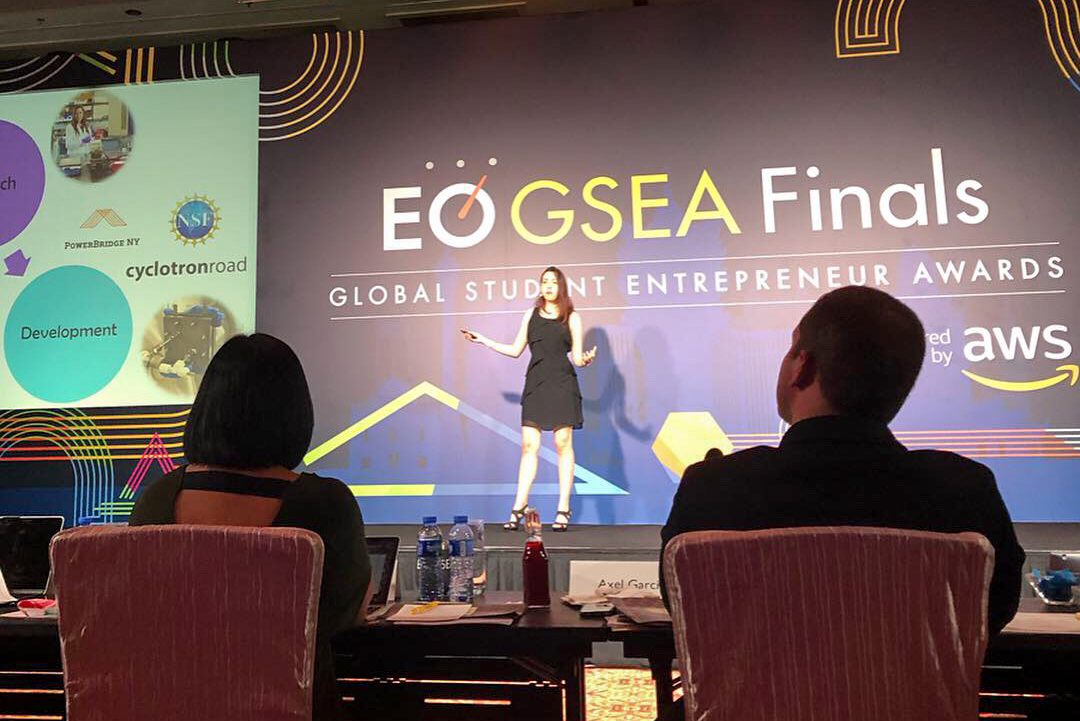
A sustainable pivot
After inventing a greener way to manufacture nylon and winning several student pitch competitions, Daniela Blanco realized investors were more interested in the artificial intelligence (AI) technology she'd developed that led to her discovery. She then pivoted her company to focus on creating AI tools to help others across the chemical industry operate more sustainably.
22 min read
Each month, our Journeys of Innovation series tells the stories of inventors or entrepreneurs who have made a positive difference in the world. Hear it in their own words or read the transcript below.
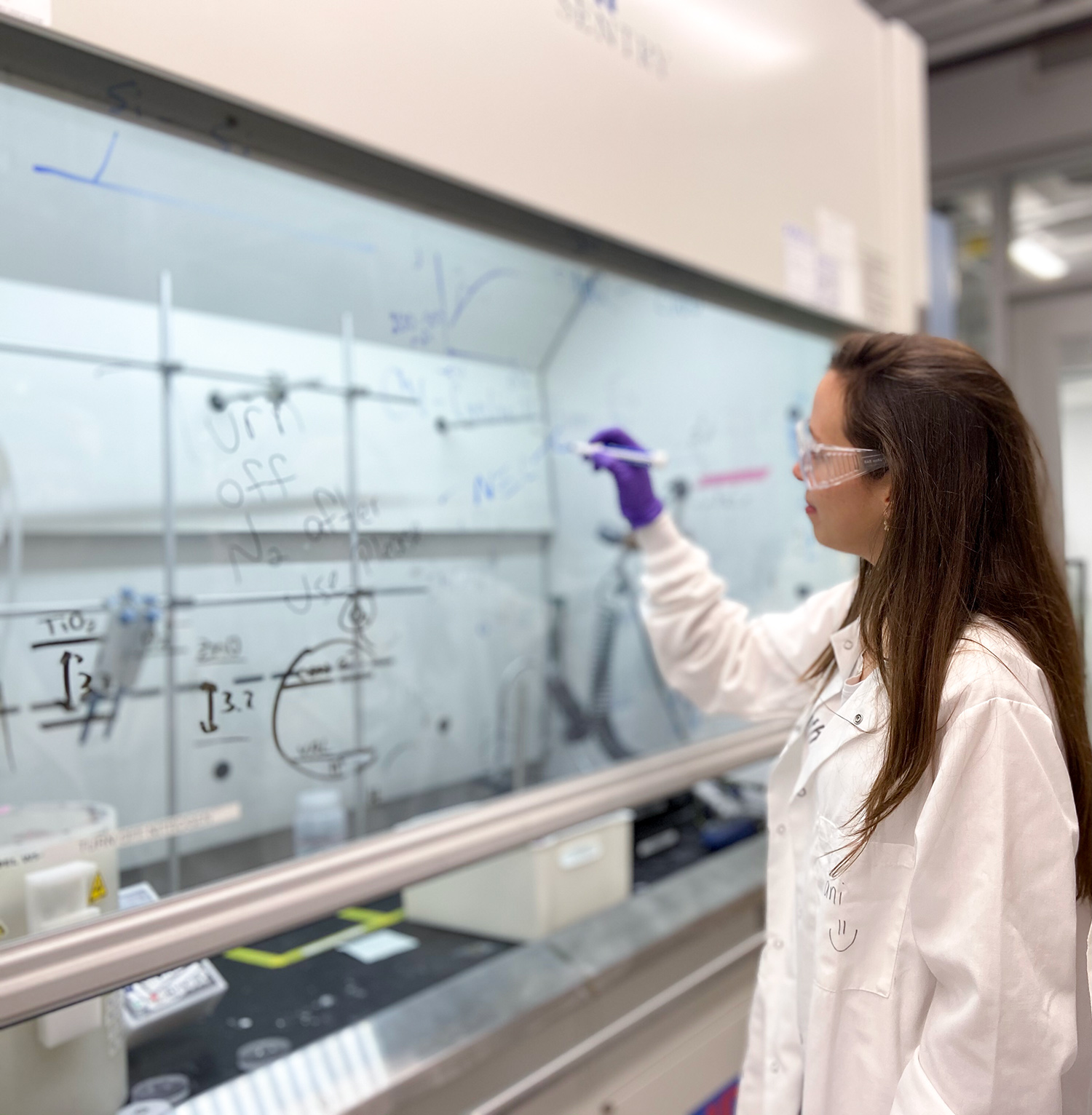
Daniela Blanco works on a chemical equation in the lab.
DANIELA BLANCO: Sustainability from now on should be profitable. Sustainability should be something that we take as a given. That we are already building new chemicals, new materials, everything — in the most possible, sustainable way.
LINDA HOSLER: Chemical engineer Daniela Blanco was looking for ways to make nylon production more sustainable, when she discovered that her innovative use of artificial intelligence technology might be able to help scientists across the entire chemical industry. I’m Linda Hosler, of the United States Patent and Trademark Office, and I interviewed Daniela about her journey — from Venezuela to the United States, and from student to CEO.
DANIELA BLANCO: It seems, you know, straightforward to think that I wanted to be part of the biggest industry that we have, which was the chemical and oil industry. But then I realized, that as much as the chemical industry makes pretty much everything we see around us today, it is also the third largest contributor to greenhouse gas emissions. And I wanted to change that. So that is why I came to the U.S. in 2017 to do a Ph.D. in chemical engineering, and learned how to develop those sustainable technologies on my own.
LINDA HOSLER: You are an engineer, an inventor, and an entrepreneur, but you call yourself a “do-er”. What are some of the things you do or have done?
DANIELA BLANCO: I think the main thing that makes me a do-er is just that I go after what I want to see accomplished. I actually don't get stuck in the little details of the things that I don't know yet; on the “what if something goes wrong?”, on the fear of something, maybe, not going exactly the way that I had planned. I just find really hard I focus on what I want to do, and I just trust that if I work really hard and I don't give up, I'll be able to figure everything out. So with that mindset, I have been able to actually not just move to the U.S., complete my Ph.D., start a company, pivot in the company a bunch of times until, you know, I make sure that I have the right solution for what is needed in the market. And now that's the way that I continue to commercialize that solution.
LINDA HOSLER: Can you tell us a little bit about your company?
DANIELA BLANCO: Yes. Sunthetics is a startup company that develops machine learning platforms that leverage very small data to enable scientists throughout the chemical industry to make new chemicals, medicine, and materials, up to 15 times faster.
LINDA HOSLER: And you mentioned already that you moved to the United States, so you actually grew up in Venezuela, as daughter to a single mom. Can you tell us what that was like?
DANIELA BLANCO: Growing up in Venezuela was incredible. I think that culture is such a big part of who we are, and Venezuelans are always incredibly optimistic. They focus on what is going right. They laugh at the things that are not going so well. And you always just keep a very good sense of humor, and you laugh about this stuff that is not going very well in your life. So, I think growing up there has probably made me very resilient. I have seen, you know, like how difficult it is to live in a country where opportunities are incredibly, at some point, limited for students, for engineers, for people who are trying to succeed there. And that's why I take it even more seriously. The big opportunity that I have of being here. I grew up with a single mom that did absolutely everything, who is just like Wonder Woman to me.
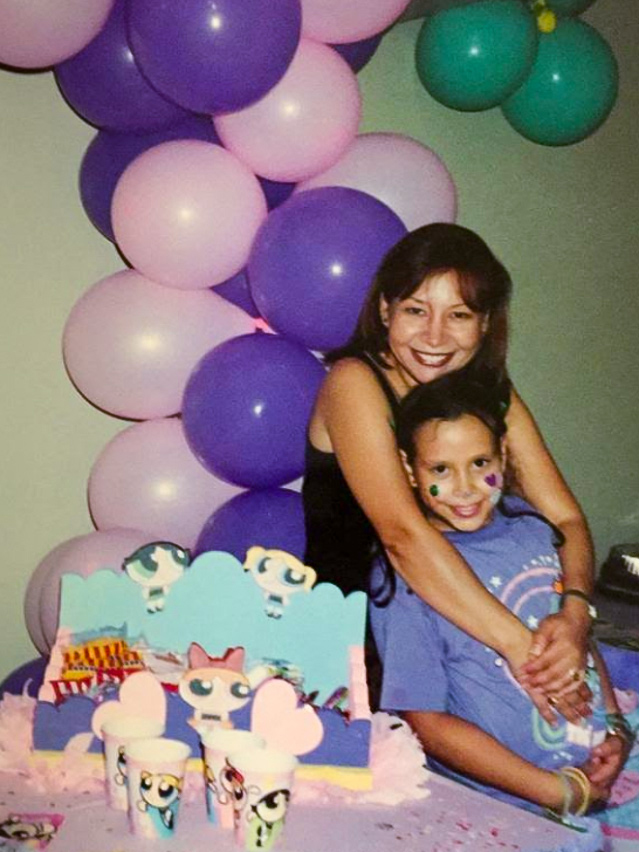
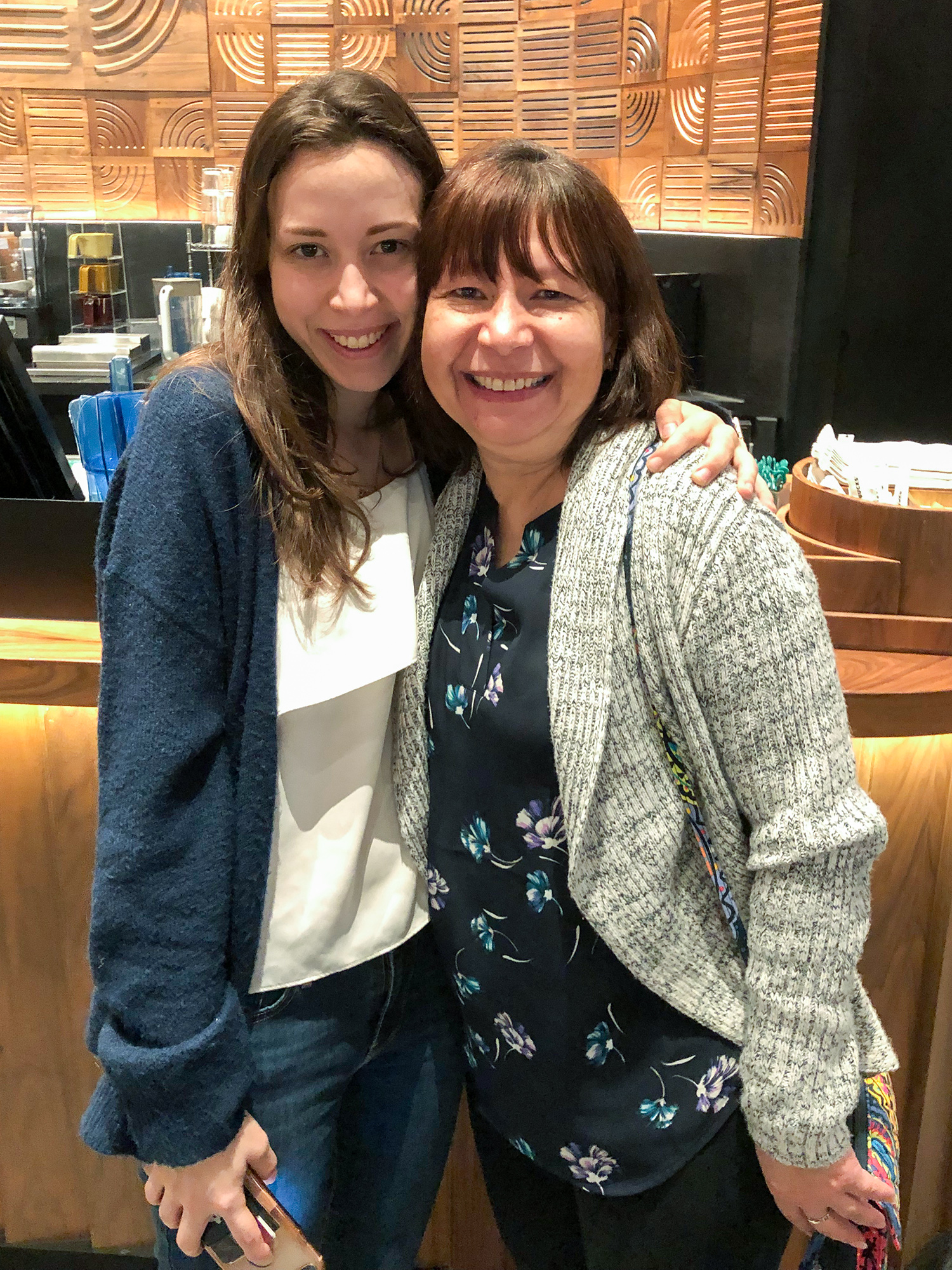
Daniela credits her mom as an important first role model and inspiration. Maria Eugenia Blanco raised Daniela as a single mother during economically challenging times in their native country of Venezuela.
And that, I think, empowered me to realize that women can do anything. That I can really go after anything that I want to do, because if my mom was able to do it; if I see day after day, Venezuelans overcoming every challenge that they have in front of them, then I can do the same thing. Moving to the U.S. was probably one of the biggest decisions that I have made, and it was pretty scary. A lot of it, you know, is way harder than what people see from the outside, but I think that if you take that jump, if you really fight for it, then it's more what you gain than what you fear.
The hardest part was definitely being away from my family and my friends. I knew one person in the city when I moved to New York, so it can be really scary. I'm super-close to my family and my friends. So, suddenly being alone, knowing that I had to start from scratch was really, really scary. Then I think the hardest part was actually when I got to the Ph.D., I realized that I felt quite out of place.
I was so behind and so out of place. So that was very hard for me, figuring out that I needed to give myself time.
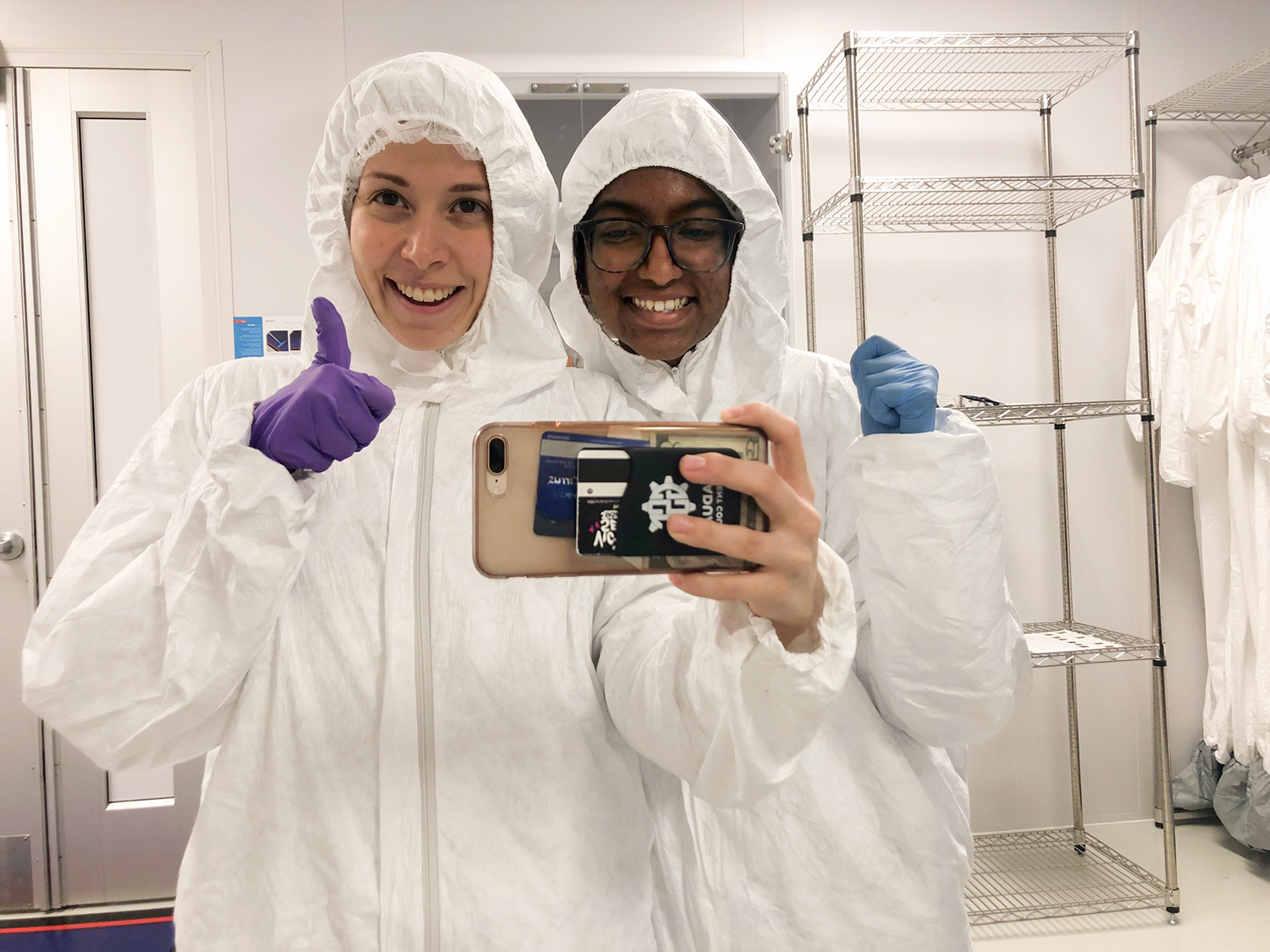
Daniela and a colleague suit up to work in a high-tech lab.
I was coming from Venezuela where my university was incredible. I was trained as a chemical engineer, but because of the political situation in the country, we didn't really have the resources for state of the art research technologies. And when I first got to the lab at NYU, I realized that I didn't even know the name of most of the instruments around me, if not all of them!
So, knowing that everyone else knew it, everyone else was up to speed, and I was the one who seemed to be so behind — it just felt like the effort that I had to do to even catch up to the point where everyone else was, it seemed like so much to do. Like, I was so behind and so out of place. So, that was very hard for me, figuring out that I needed to give myself time. That I needed to feel comfortable with what I knew, because what I knew at the time was just the starting point. It didn't mean that that was all that I was gonna know. I just had to give myself a chance to learn, to catch up with everyone, and then to continue growing on my own, at my own rhythm.
LINDA HOSLER: So, you said that you already had training as a chemical engineer in Venezuela. Where did that come from? You told us a story that as a preschooler you saw a cool experiment with a bone and Coke. What was that experiment and how did it inspire you?
DANIELA BLANCO: Yes, when I was like four years old, the teachers made this experiment where they used two chicken bones, and they put one in a glass of water and then one in a glass with Coke. And they left it there. I don't remember for how long exactly, but I just remember I was a kid, and I was shocked when I came back, and I saw that the little chicken bone that had been in Coke was destroyed. It looked so bad. And then, you know, I was asking like, “what's going on? Like, who can fix this? What can we do?” And then I just remember somebody telling me, you know, that's science. Like medicine is involved. There are a lot of chemistry that has to do with, how this, like these materials work and how we can protect bones, and more and more.
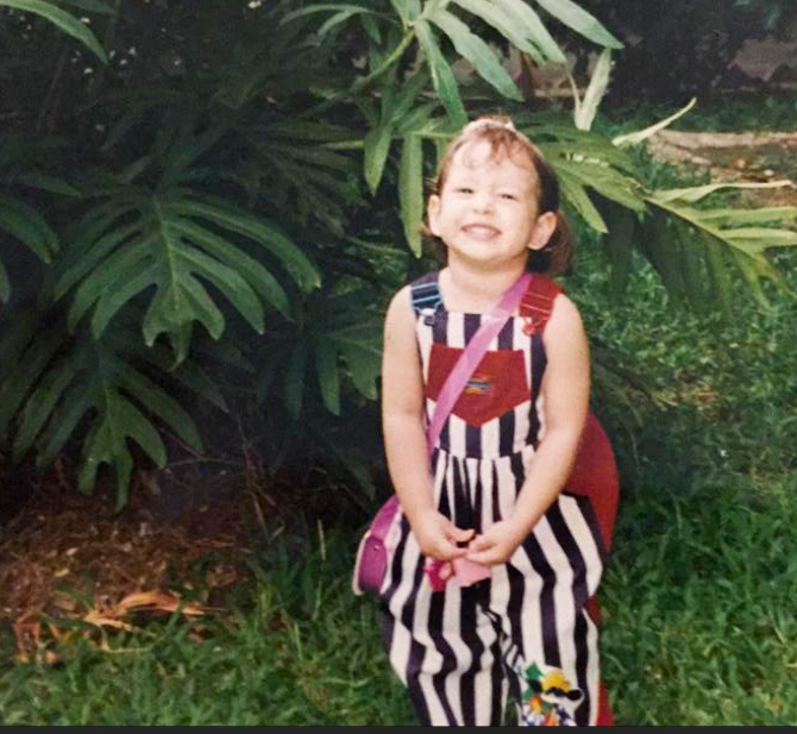
Even at a young age, Daniela was fascinated by science and wanted to learn more, thanks to a surprising science experiment she observed.
And that's when I realized, and I told my mom, I want to do science, but I wanna do the good kind of science. You know, I want do the kind of science that fixes this, that can do something that is important for people. Of course, I grew up and it actually turned out not to be at all related with chicken bones or Coke! But I did stick to my dream of being a scientist, of going after that. And overall, just doing science that would have an impact. Doing science that could be helpful for people.
LINDA HOSLER: How do you think that first introduction to chemistry and science, how did that evolve into wanting to be a chemical engineer specifically?
DANIELA BLANCO: Yes. So actually after that, my idea was that I wanted to be a doctor. I wanted to study medicine. I wanted to be a neurosurgeon. That was the plan. And then right before graduating, something that my high school used to do, that I think is incredibly useful, is that they would let you do a vocational internship. So, you take a week where you go to a company where they do what you want to study, mainly just to give you the opportunity to realize if that is truly what you're after. And I went to a hospital. I was supposed to see some surgeries, and then go [between] different types of medicine applications and see what I wanted to study. And the first one was dermatology, which was supposed to be, like, very easy. Well, not easy — but you know what I mean?
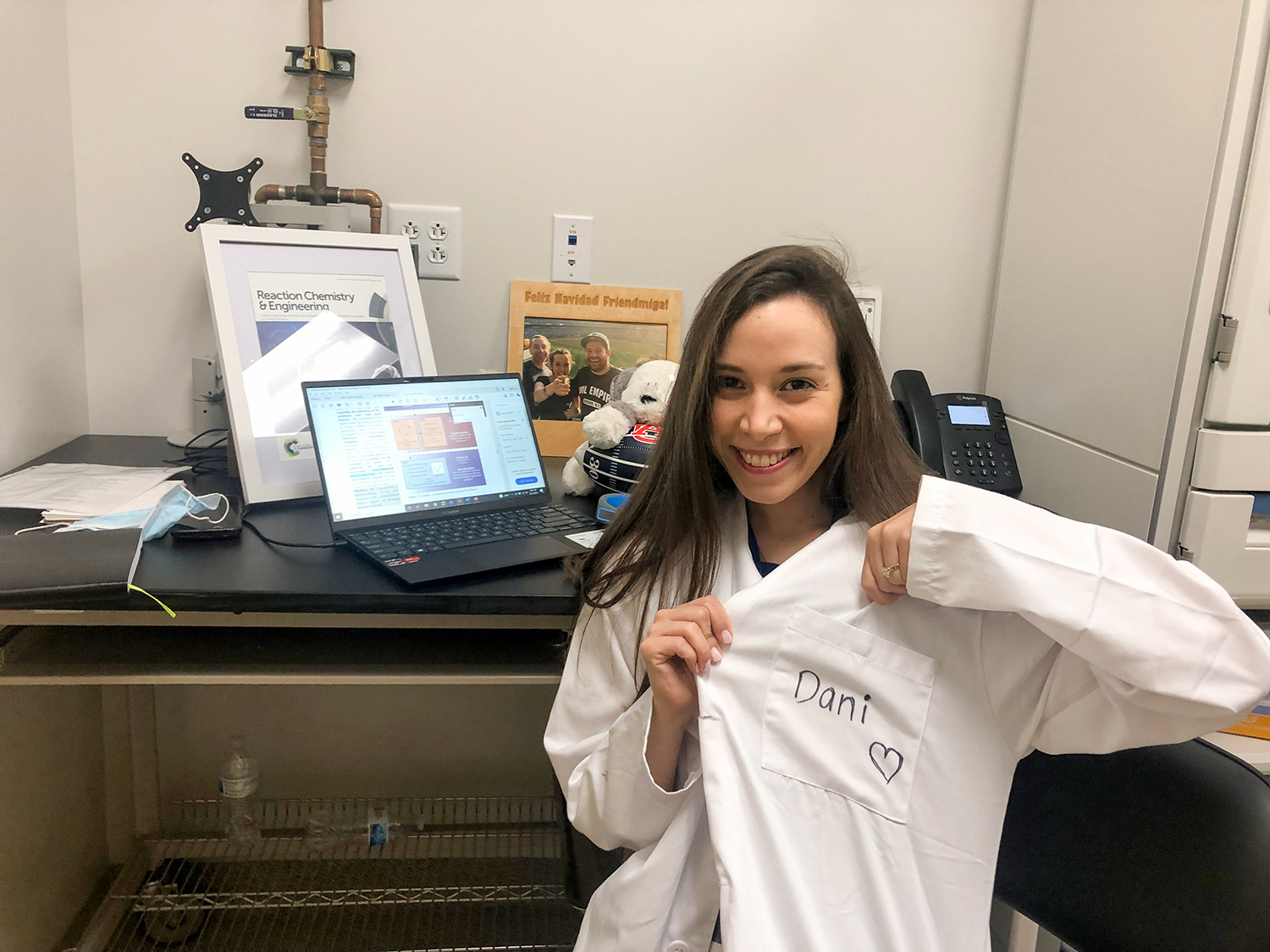
Daniela proudly shows off her personalized lab coat, inscribed with her nickname "Dani."
It was supposed to be way less shocking than something like neurosurgery, and I actually realized that I couldn't stand blood. It happens to many people. I couldn't stand the sight of blood. The doctor that was actually performing the little surgery pretty much had to stop at some point to take care of me, because I was almost fainting when the patient was on the table. And you know [the patient], they were fine. I was the one who was not doing well. I realized that I had such a hard time, you know, dealing when patients were getting bad news and they were getting stressed. I would get super stressed, like the empathy. It was just so big and so stressful on me, that I realized it didn't feel right for me. My second option was to study something with chemistry.
And then I went to the biggest chemical company in Venezuela, and then I realized that chemical engineering was incredibly exciting. They did so many cool things, and I particularly remember this one stop in our internship where they were making ice cream. It was an ice cream factory, and there was a chemical engineer whose job was to taste the ice cream that they were making. And then I was like, there is no way that I'm gonna go, after having to deal with blood and all of that stress, when I could be a chemical engineer and make that my job! So, that's why I ended up going into chemical engineering.
And, again, my job doesn't really have to do with tasting ice cream, but yeah, chemical engineering is one of those fields, like many others, where you can do so many different things. I just ended up finding my own way within the field.
LINDA HOSLER: You mentioned that you eventually moved to the United States to pursue a degree at New York University (NYU), and that's where you developed the invention that is at the core of Sunthetics. So inventions, as you know, come from identifying a problem that needs to be solved. What was the problem you wanted to solve, and who helped you develop your invention?
DANIELA BLANCO: When I started the Ph.D., my thesis was around making electrochemical processes more efficient, and the reason to do that is because you take a chemical reaction that is normally powered with heat. Heat comes from burning fossil fuels, so it is incredibly polluting. And so my Ph.D. thesis was going to be focused on changing that. So that by making it electrochemical or electricity-driven, you could get the energy from renewable energy sources, like solar energy, wind energy — anything like that. So, I focused on developing an electricity driven or solar-powered route to make nylon intermediates. And as you know, nylon is used in clothing and a lot of our exercise clothes, the firefighters’ gear, a lot of materials that are in cars today. So, it was a technology that would have a really big application, and it was bringing a very sustainable technology and invention to the chemical industry.
I wanted to make sure that my invention wouldn't just stay somewhere on a paper, published. I wanted to make sure that it would get to industry and that it would get implemented.

Beginning in 2018, Daniela competed in a series of increasingly high-profile business pitch competitions, winning prize money to help fund her new company. In 2021, Sunthetics received a Small Business Innovation Research (SBIR) Phase I grant from the National Science Foundation, enabling her to continue her work.
So, I was incredibly excited about it, and that is what moved me to continue working on it. But, as I was a Ph.D. student, I wanted to make sure that my invention wouldn't just stay somewhere on a paper, published. I wanted to make sure that it would get to industry and that it would get implemented. So, I started joining the entrepreneurial institute. They had different classes and they would teach you a little bit about what was required to start commercializing a technology.
And then I signed up for entrepreneurial competitions with a goal of just kind of having deliverables and getting to see what people were supposed to do. I didn't really think we were gonna win, but surprisingly we won. So, we got money and that's how Sunthetics was born. We got incorporated when, to be honest, I don't think anyone saw it coming! And yeah, then my initial idea was to build Sunthetics as a company that would make solar powered chemicals. But as it happens to many people, when I kept asking companies, you know, “how willing [are you] to implement this?", “What was required to do that?”
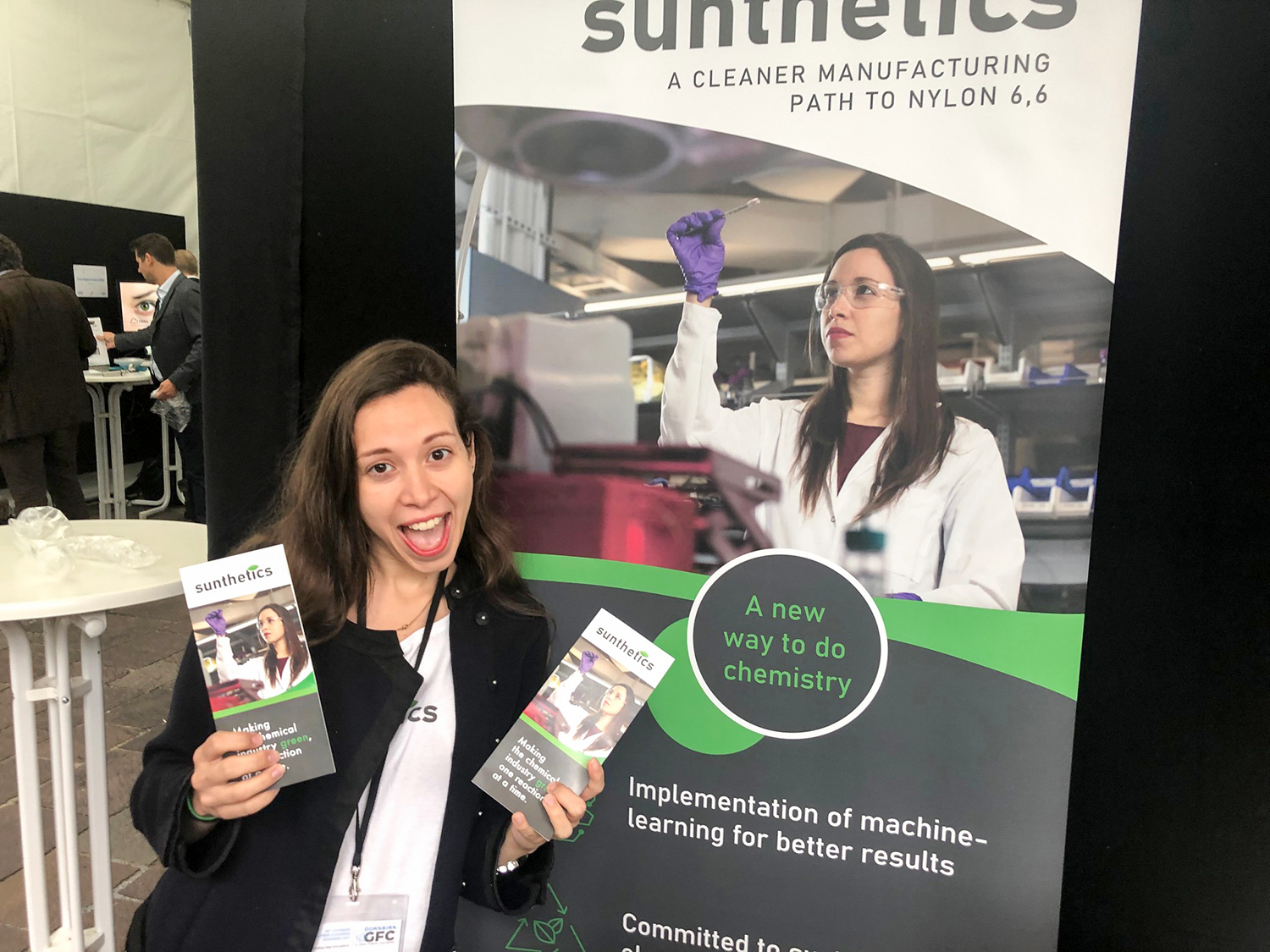
Daniela's company, Sunthetics, pivoted from promoting new methods of Nylon manufacturing to a broader commercialization of the innovative AI-powered tools behind the initial discoveries. In this early company photo, the brochures and banner emphasize the original company focus of manufacturing Nylon 6,6.
I realized that implementing that technology that I had in mind was very difficult, not just because of the market trends, but also [because] the need or the motivation to implement it wasn't really there. And we, you know, we could like fool ourselves and continue repeating that it was such a good technology that it was gonna find its way, but we chose not to do it. Because when you do that, you usually are just flipping a coin and hoping for the best to happen. Instead, we continued asking questions and I continued being like, “okay, what do you need? What, how can you make, you know, other processes more sustainable? What would you be willing to implement?” And I realized that in our case, for example, to make the nylon process work, I ended up using artificial intelligence. That was the case. That was the way to get it to a very high efficiency.
I myself am an immigrant. I didn't necessarily have a safety net of, you know, a lot of money or savings. I started the company knowing that I needed a salary.
And then I started asking people, “Okay, what if I can give you AI that you can use, not just for nylon, but for other processes? And you can make them equally as sustainable. You can make them solar-powered, you can make them faster, you can make them better?” And then we saw an in, then we saw like true motivation from people to start implementing it, and they were asking for it. So, we made a pivot. And after I graduated from my Ph.D., I focused on developing a machine-learning platform that would be reaction-agnostic that you can implement for nylon, for medicine, for cosmetics, for basic chemicals, for anything you want — to be able to develop processes that are more sustainable, faster, and overall more efficient.
However, saying that at the beginning and starting the company is very different from keeping it going. Because, as you know, entrepreneurship it has so many ups and downs, and one day you feel so good about what you're building, for the next one to have everything go wrong, and make you doubt yourself so much.
So, it is very difficult, and I myself am an immigrant. I didn't necessarily have a safety net of, you know, a lot of money or savings. I started the company knowing that I needed a salary. I needed the company to have some funds to be able to pay me, because otherwise I couldn't live. So it's very scary. It's a lot of risk that is involved, and you really have to hope for the best, work really hard, but also trust that you're building something that is worth it.
And today, we actually have six people working at Sunthetics, and seeing that they're just as motivated, that they're just as committed, that they would, you know, not sleep through the night because we are onto something, and we know that we can get this to work — that is huge, and that makes me feel like I'm not alone.
LINDA HOSLER: What role did patents and intellectual property play in the development of your invention and your company?
DANIELA BLANCO: Before I got to NYU, I didn't even know how any of this worked. So, it was a huge advantage to have the legal support from the university to understand what was required and why it was so important. And then as a company, it becomes even more important, right? Because you're, as a startup especially, you're so tiny and you have, you know, such a good idea, but your company truly relies on that. This is the core of our business, and this is everything for Sunthetics. So, knowing how to protect it, knowing how to stay ahead of competition, that is huge for us. In our case, it is actually really interesting, because since we work on AI at the company, we realize that patents are incredibly, you know, great for certain types of inventions, but you have to be really careful, and you have to understand, for your specific invention, for your specific idea, what is the best way to protect it. That's not always patenting. Sometimes, you know, it goes from copyrighting to keeping it as a company trade secret. In our case, we have made a strategic decision to keep it as a company secret.
...as an inventor, you are the one who can make the best decision as to how much your idea matters, how much it should be protected, and what is the best way to protect it.
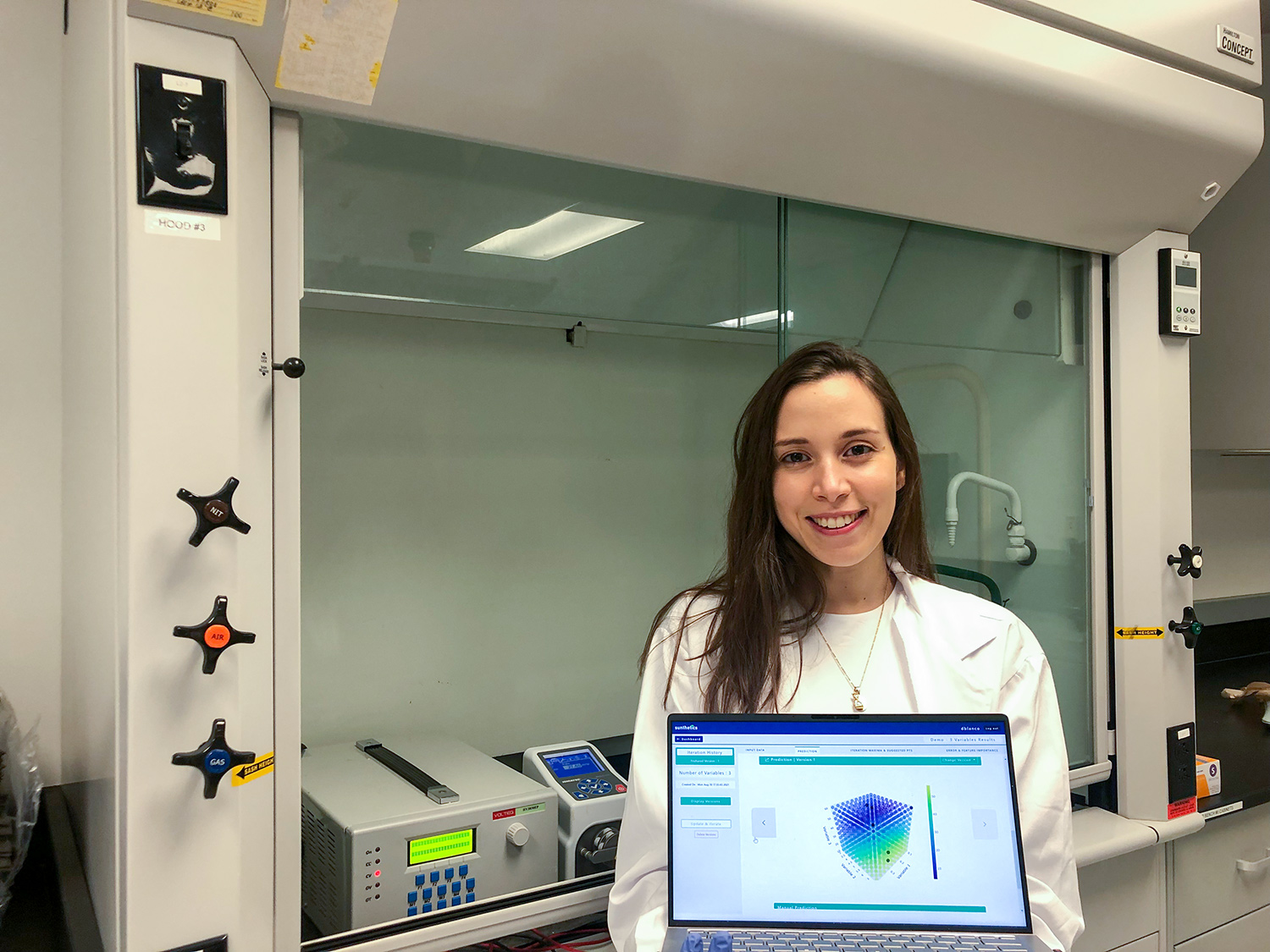
Daniela holds a laptop running the proprietary AI software she created. Rather than apply for a patent, she decided a trade secret was the best way to protect her AI innovations that form the key intellectual property of her business.
I think that as students, as engineers, as inventors, many times, we don't realize that there are so many different options. And, it's not about just asking one person and seeing what they think is right. It's about really thinking it through, because at the end of the day, as an inventor, you are the one who can make the best decision as to how much your idea matters, how much it should be protected, and what is the best way to protect it.
LINDA HOSLER: So, you mentioned patents and copyrights as part of your IP strategy and also trade secrets. Can you talk about your IP portfolio and how you think about it strategically when it comes to your company?
DANIELA BLANCO: The IP in our case comes from how we integrated chemical engineering knowledge with traditional AI to be able to make AI more powerful and leverage small data sets in a more effective way. That's where our IP comes from. And then the question was, how do we protect it best? We have the option of patents and I actually drafted the claims for one of our first patents, but then we started thinking more and more about what it would mean to us on the competitive landscape. And then you realize that, even though we're not disclosing the algorithm itself, we are still giving hints somehow as to what we're doing, you know, the thought process, what matters, what doesn't matter, what is it that you need to really think through, and what are the things that have to start coming together for our technology to work.
In our case, the decision to keep it a trade secret was based on two things. One of them is that we didn't wanna give too many hints as to what we're building, because a huge part of commercializing this in a successful way comes from being first to market. Being one of the first to really bring this to companies and, you know, having a widespread adoption before anyone else catches up with us. And then, the second decision is because sometimes you have to think about how easy or how difficult it's going to be to enforce a patent and enforce the protection that you have built around it. In our case, we have algorithms that help make chemicals more effectively and more sustainably, but the end product, the chemical, looks the same. So, think about it that if you go to buy today a new medicine, you know what medicine is in there, but you don't know how it was built. So, we have no way of knowing if that medicine or that new chemical or that new material was built using an algorithm that is, you know, infringing our patent, or it isn't. So, being able to prove that somebody was going against [the patent] or that somebody was doing something wrong was incredibly difficult in our case, which is why overall we decided to keep it a trade secret.
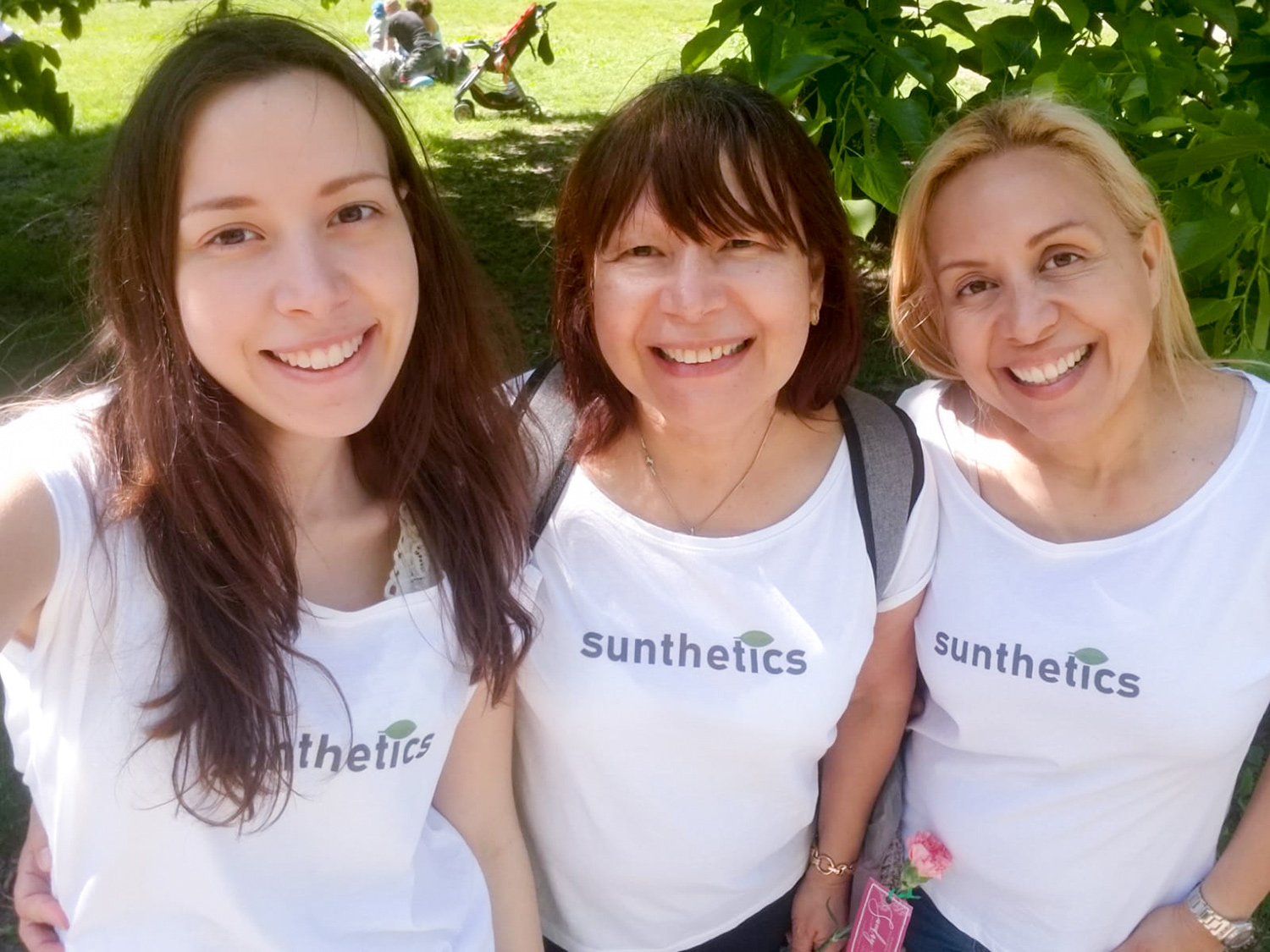
(Left to right): Daniela, her mother, and her aunt in matching Sunthetics t-shirts.
LINDA HOSLER: You've mentioned how your mom was an inspiration for you, and you've also spoken about how important it is for girls and women to pursue STEM careers and start businesses. What advice would you like to share with young people?
DANIELA BLANCO: I would say, especially for girls, remember that nobody can make you feel any less, unless you let them do that to you. People can say whatever they want. People can think whatever they want. If you know your value, if you know your worth, if you trust your knowledge and your motivation and your hard work, then you have nothing to fear, and you have nothing to fight or be upset about. That's the way that I handle it whenever I get a comment that makes me uncomfortable or that I don't agree with. Whenever I find something that doesn't believe in me, just because I'm fairly, I'm a girl or I'm too young or anything similar, it's not worth a fight. It's not worth getting upset. It's just more motivation to work hard and to show them that they were wrong. You don't have to do anything, let actions, let results, speak for you.
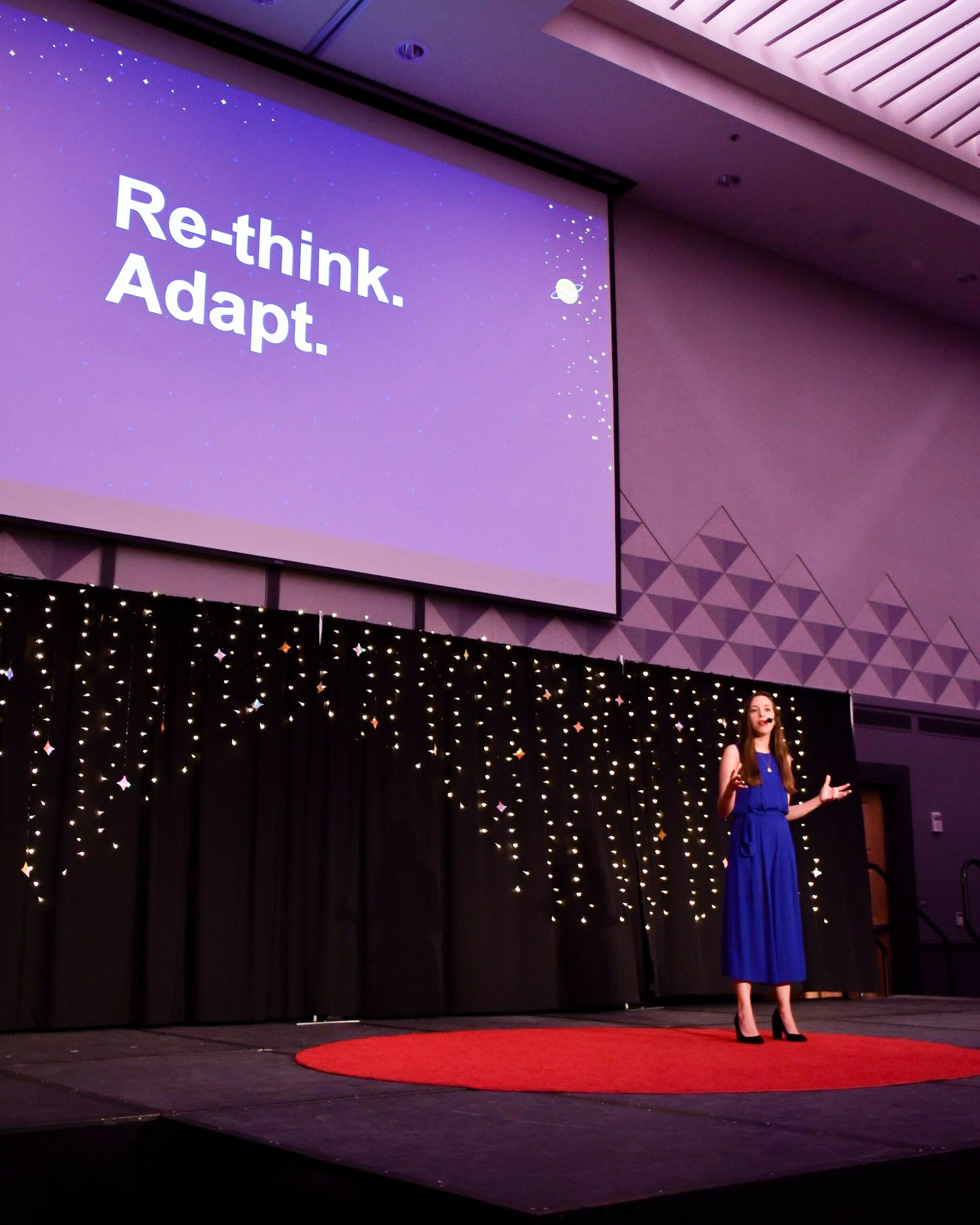
Daniela gave a 2022 TEDx talk titled "If AI shapes our future, who shapes AI?"
LINDA HOSLER: What do you think it takes to be a successful innovator?
DANIELA BLANCO: I think to be a successful innovator, the main thing is that you can't be afraid of what you don't know. When you're innovating, when you're inventing, you're right at that limit of what is known. You're building something so new it's, it's incredibly exciting. It's also really scary. It's very hard because you don't have a lot to guide you. But, if you're not afraid of it, if you're comfortable with the fact that you're just learning and you're coming up with new things, and you're probably going to fail, but if you fail, you fail fast, and then you fix it, and you try again until you get it right. Then, you're on the route to build something great. Just don't be afraid.
AI is just something that boosts our capabilities on our productivity. AI was created by humans and AI continues to be shaped by humans. It's up to us to decide how it's used, how far it's gonna go. It's tricky and it's big, you know, because it's, it's up to us, not just to make it something huge, but it's up to us and it's our responsibility to make sure that it's used in the right way. That it has, you know, like all of the ethical implications, that we don't forget any of that, but I think AI has the potential to do so much for our society.
I think every single day, we're thinking of new applications, new ways to use AI, but what I want people to remember, is that sometimes we can't forget the fields where it's not being implemented, like it was for the chemical industry. In stages of chemical manufacturing, where we didn't have a lot of data, AI was being left completely behind. And it was up to us to, to start thinking about how do we change AI to be able to leverage small data? How do we shape that? Because it can't be that the limit is just on the traditional application of big data.
So, I hope we continue realizing that AI can go as far as we want it to. In terms of green chemistry, I'm just excited because I'm finally seeing this change in our generation.
And I wanted to keep growing, that we should not see sustainability as something hard to get. We should not see it as a sacrifice that, oh, you know, this is more expensive, but it's more sustainable. Or, like this was so hard, but at least it's more sustainable. No. sustainability should be an asset. Sustainability from now on should be profitable. Sustainability should be something that we take as a given, that we are already building new chemicals, new materials, everything in the most possible, sustainable way.
LINDA HOSLER: That's amazing. I love hearing all of that. It’s so inspirational. So, I appreciate your sharing that perspective with us. What are you the most proud of when it comes to your work so far?
DANIELA BLANCO: I'm most proud of when I didn't give up when things were really hard. Once you have made it through that hard stage and things are going well, awards come and prizes and recognition comes, because you've worked really hard and you have built something huge. I am proud that I didn't give up. I'm proud that I kept fighting for my dreams. I think I am most proud of the fact that every day when things get complicated in the startup, I don't give up. I keep fighting for it. And, and I'm proud of the fact that I think every day I'm building a better version of myself, not just on the personal level, but intellectually, you know. I know more today than I knew yesterday, because every day I'm working on something so new, so different, so scary, but I figure out a way to do it. And then every time I do that, every time I figure that little thing out, it gives me this sense of satisfaction and it makes me really proud.
LINDA HOSLER: From the USPTO, thanks for listening!
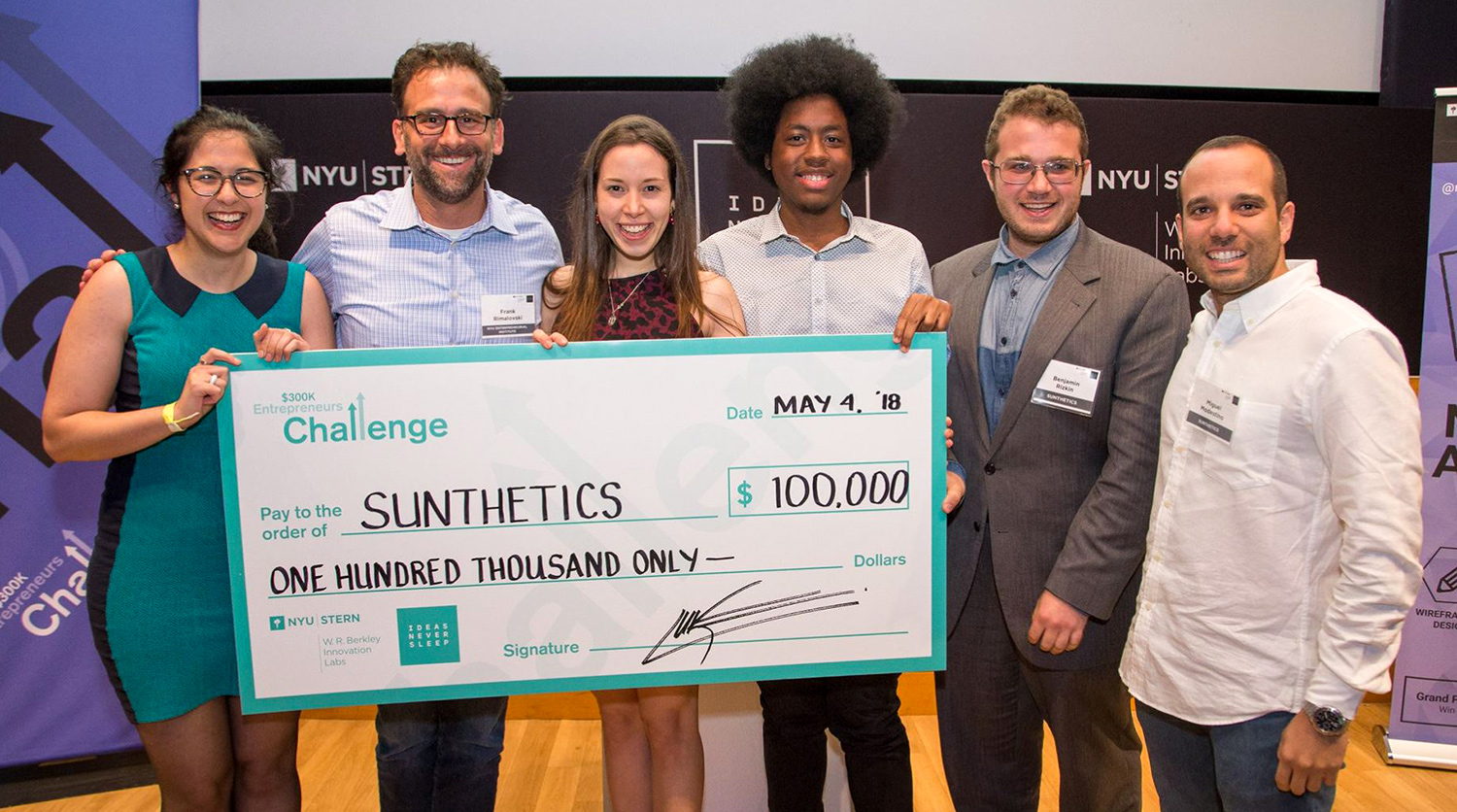
Surrounded by her team and supporters, Daniela celebrates a successful pitch competition that brought funding to her new company, Sunthetics.
Credits
Produced by the USPTO Office of the Chief Communications Officer. For feedback or questions, please contact inventorstories@uspto.gov.
Interview by Linda Hosler. Audio editing by Jay Premack. Story production by Laura Larrimore. Photo on the USPTO homepage and throughout this story courtesy of Daniela Blanco.
References
Blanco, Daniela. "If AI Shapes Our Future, Who Shapes AI? | Daniela Blanco | TEDxUF." Youtube video. 12:28, May 23, 2022, https://www.youtube.com/watch?v=y7dst-Gywa4.
National Science Foundation. "SBIR Phase I: Implementing AL-enhanced Machine-Learning for Advanced Electrochemical Manufacturing," August 20, 2022, https://www.sbir.gov/glossary-entry/non-final-decisions-orders5



